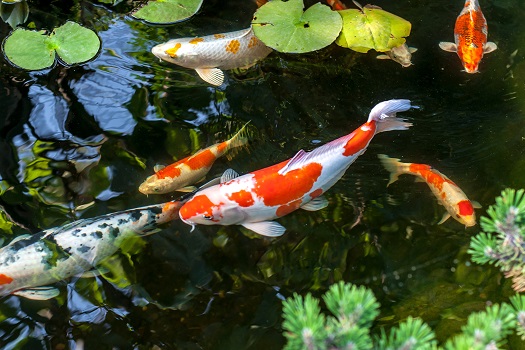- Your shopping cart is empty!
5 Mistakes to Avoid Making with Your Koi Pond

In the rush to enjoy their beautiful fish, people often make simple blunders when starting koi ponds. These mistakes can be harmful—and even deadly—to the koi. The experts at Aquatic Warehouse, a leading provider of koi pond and fish tank supplies, recommend avoiding these errors to ensure a long-lasting habitat full of healthy, happy fish.
1. Building the Pond Too Shallow
Many prospective koi owners assume a shallow pool is better for observing their fish. However, ponds require at least 10 gallons of water for every 1 inch of koi. The fish require depth to develop their ideal “torpedo-shaped” bodies—large in the middle and tapered at both ends. In a deep pond, koi can regulate their body temperatures, staying cool in the summer and comfortable in winter. Less sunlight reaches a deep pond bottom, so algae won’t flourish there. Ponds should be 36” deep with no shallow areas so the koi can escape predators like herons and raccoons.
2. Not Giving the Koi Enough Oxygen
Warm water has less of the oxygen koi and pond plants need to live. Especially during the summer, a waterfall feature doesn’t provide sufficient aeration for a pond. It’s better to have a waterfall or an aeration drain at the bottom of the pool that filters out the water with the least oxygen and returns it to the surface to be replenished. You can also add exterior pumps and air stones, which sit at the bottom of the pool producing oxygen bubbles.
3. Rarely Changing the Water
Water changes are essential to removing waste and pollutants from a pond. A common mistake pond owners make is thinking that adding water that has been evaporated is the same as doing a water change. Nope. Bad water quality can stunt the growth of the koi and lead to disease and death. Like many living things, koi fish communicate with one another by releasing natural chemicals called pheromones. In a small, heavily populated pond, fish often produce aggressive pheromones. When these chemicals build up, they are detrimental to the health of the community—another reason regular water changes are crucial. You should drain out and replace 10-20 percent of the pond water per week. Use this nutrient-rich water to feed your garden plants, then watch them really grow!
4. Adding Chlorinated Water without Neutralizing It
When refilling a koi pond with fresh water from a garden hose, make sure to add a chlorine/chloramine neutralizer to the pond. If the tap water runs for too long, the neutralizer will be expended and chlorine levels in the pond will quickly become dangerously high. Chlorinated water burns the fish’s gills, which could kill them within hours. Start a timer or buy a water shut-off valve to prevent this disaster.
5. Not Testing the Water
Koi fish don’t handle change well. Even small shifts in the pond environment can have unwanted consequences. Use a proper testing kit to keep the pond water within healthy parameters. Measure for ammonia levels, which can be lethal if they rise above zero. Nitrate and nitrite levels should also be kept as close to zero as possible.
If you need the right pond equipment to keep your koi pond running smoothly, stop by Aquatic Warehouse in the Kearny Mesa area. You can also order the supplies you need on our website, or if you have any questions, feel free to give us a call at 858-467-9297.
